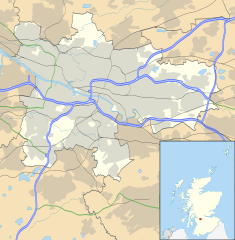Whiteinch Burgh Hall
| Whiteinch Burgh Hall | |
|---|---|
 The building in 2021 | |
| Location | Victoria Park Drive South, Glasgow |
| Coordinates | 55°52′28″N 4°20′03″W / 55.8744°N 4.3343°W |
| Built | 1894 |
| Architectural style(s) | Scottish Renaissance style |
Listed Building – Category B | |
| Official name | 35 Inchlee Street, 15, 16 Victoria Park Drive South Former Whiteinch Burgh Hall and former police station, former fire station including boundary wall, gatepiers and railings |
| Designated | 16 May 2006 |
| Reference no. | LB50283 |
Whiteinch Burgh Hall is a municipal building on Victoria Park Drive South in Whiteinch, part of Glasgow, Scotland. The burgh hall, which is currently derelict, is a Category B listed building.[1]
History
[edit]Following significant population growth in the area, largely associated with the shipbuilding industry, Partick Burgh Council decided to commission a local events venue for the Whiteinch area.[2] The site they selected was adjacent to Victoria Park, which had been part of the Oswald family estate, centred on Scotstoun House.[3]
The new building was designed in the Scottish Renaissance style, built in red sandstone and was completed in 1894. The design involved an asymmetrical main frontage of four bays facing onto Victoria Park Drive. The first bay on the left featured a doorway with a curved pediment. On the ground floor, the other bays contained small bi-partite windows while the first floor was fenestrated by tall mullioned and transomed dormer windows with alternating triangular and curved pediments. The bays were separated by buttresses and there was originally a central roof lantern. At the east end, there was a round doorway with a keystone and roundels in the spandrels; on the first floor, there was a mullioned and transomed window with a triangular pediment, set in a large round headed arch, all surmounted by a gable. The east end also featured a pair of full-height towers flanking the central bay. Internally, the principal room was the main assembly hall which featured a stage and some fine plasterwork.[1]
A single-storey police station was erected to the immediate south of the burgh hall and a three-storey fire station was erected to the south of the police station. A gabled two-storey extension was erected to the west of the fire station in 1905: this accommodated the local masonic lodge, St John's, throughout much of the 20th century.[4]
The burgh hall continued to be administered by Partick Burgh Council until the burgh of Partick was annexed by Glasgow Corporation in 1912.[5][6] The congregation of the local Baptist church met in the burgh hall in the early part of the 20th century.[7] It became a popular venue for concerts, with the pianist, Desirée MacEwan, who was a preceptor at the Royal Academy of Music, performing there in 1926.[8] During the Second World War, dances were frequently held there.[9]
In the 1990s, the building was adapted for use by Glasgow City Council as a community centre. However, this use came to an end in 2002,[10][11][12] and the building was deemed surplus to requirements in 2006. It subsequently became dilapidated and was placed on the Buildings at Risk Register for Scotland.[13][14]
See also
[edit]References
[edit]- ^ a b Historic Environment Scotland. "35 Inchlee Street, 15, 16 Victoria Park Drive South Former Whiteinch Burgh Hall and former police station, former fire station including boundary wall, gatepiers and railings (Category B Listed Building) (LB50283)". Retrieved 25 August 2024.
- ^ "Paul Sweeney: Don't let Whiteinch Burgh Halls suffer Springburn's fate". Glasgow Times. 14 April 2023. Retrieved 25 August 2024.
- ^ "Ordnance Survey Six-inch 1st edition, 1843–1882". Retrieved 25 August 2024.
- ^ Historic Environment Scotland. "Glasgow, 35 Inchlee Street, Whiteinch Burgh Hall". Canmore. Retrieved 25 August 2024.
- ^ "Partick Burgh Hall". The Glasgow Story. Retrieved 25 August 2024.
- ^ "How Glasgow annexed Govan and Partick 100 years ago". BBC. 7 August 2012. Retrieved 25 August 2024.
- ^ Yuille, George (1926). History of the Baptists in Scotland from Pre-reformation Times. Baptist Union of Scotland. p. 187.
Services previous to this were held in the Whiteinch Burgh Hall
- ^ The Scottish Musical Magazine. Vol. 8. 1926. p. 97.
The recital given by Miss Desirée MacEwan, a young preceptor of the pianoforte in the Royal Academy of Music, and Miss Maud Anderson, cellist, was particularly enjoyable
- ^ Dancing Times. 1944. p. 231.
A former member of the Plaza staff is running Saturday evening old time dancing in Whiteinch Burgh Hall
- ^ "Derelict Whiteinch Burgh Hall seen from new angle as locals fight to save historic building". Glasgow Live. 18 January 2021. Retrieved 25 August 2024.
- ^ "Action demanded to secure 'at risk' Glasgow building empty for decades". Glasgow Live. 11 April 2023. Retrieved 25 August 2024.
- ^ "Safety concern for Glasgow's historic buildings after Whiteinch Burgh Hall sealed off". Glasgow Live. 12 May 2023. Retrieved 25 August 2024.
- ^ "Whiteinch Burgh Hall". Buildings at Risk Register for Scotland. Retrieved 25 August 2024.
- ^ "Whiteinch Burgh Hall". Derelict Glasgow. Retrieved 25 August 2024.
External links
[edit] Media related to Whiteinch Burgh Hall at Wikimedia Commons
Media related to Whiteinch Burgh Hall at Wikimedia Commons

